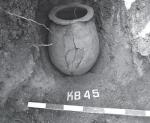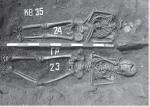Summary (English)
ARCHAEOLOGICAL EXPLORATIONS NEAR BANSKO (Vladimir Baryakov – vlbaryakov@mail.bg) The settlement covered an area of 2.5 – 3 ha. An inner town existed, which covered 0.5 – 0.6 ha and part of its fortification wall, 1.20 m wide, was discovered together with a northeastern square fortification tower built of ashlars bonded with mortar. Rooms of houses were explored. Their walls were built of stones bonded with mortar, 65 cm wide and preserved up to 3.20 m in height. The settlement was burned and a layer with traces from fire, 40 – 60 cm thick, was documented together with collapsed roof constructions. After the fire, the buildings were reconstructed with reused cut stones and bricks. The new walls were constructed over the still existing walls from the previous period, but mud was used as a bonding medium. Dolia were discovered in the rooms, placed in conical pits dug out into the bedrock and supported with clay and sand. Other ceramic vessels were placed in similar smaller pits. The finds included fragmentary window glass and glass vessels, two lead seals of the 9th – 10th century and the second half of the 11th century, hundreds of coins dated from the 3rd to 18th centuries, bracelets, earrings, finger-rings and a bronze vessel. Sixty-five graves were explored, situated to the east and to the north of the basilica. Three types of burial constructions were documented: burial pits dug out into the bedrock, burial pits surrounded with cut stones and building ceramics, and burial chambers constructed of cut stones and building ceramics bonded with mortar. The deceased were children and adults, some of them over 2 m in height. The grave goods included pottery, finger-rings, earrings, bracelets and coins from the 3rd to 17th centuries. Two metallurgical kilns were discovered to the east of the inner fortification wall.
- Vladimir Baryakov - Museum Complex – Bansko
Director
Team
Research Body
- Museum Complex – Bansko






![Download [PDF]](/excavation/skins/fasti/images/results/download_sml.png)

